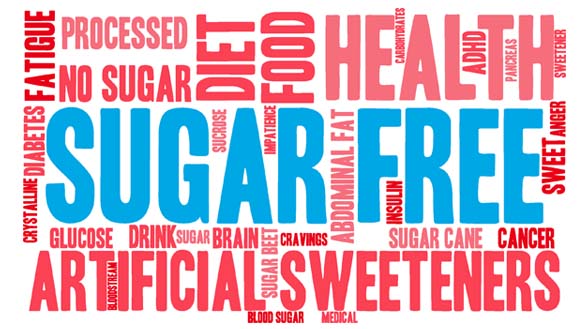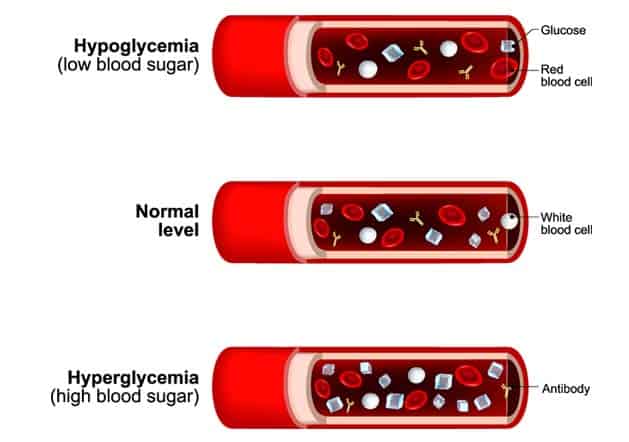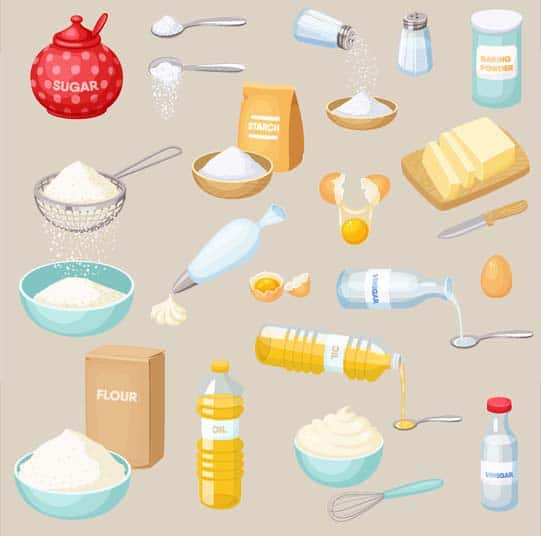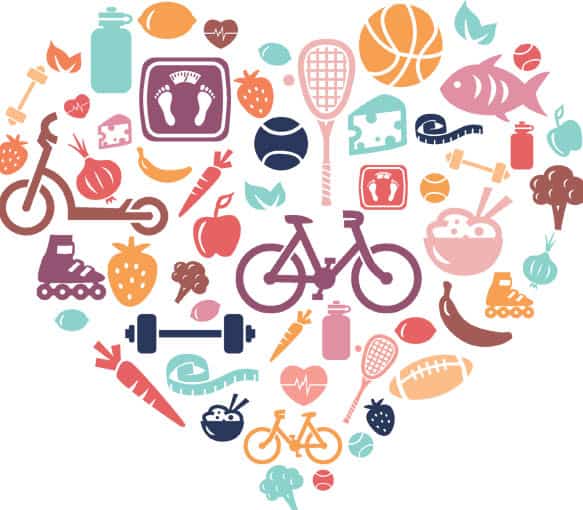
What is that saying? Everything is good but only in moderation? Well this rings true when it comes to eating sugar with diabetes too.
You probably already know that eating a lot of sugar is not great for your body. The problem is that sugar comes in a natural form and in an added form, so sometimes you have no idea that you are consuming it.
Also, it is in many foods that you don’t even think to consider. Foods that you think are healthy, such as tomato sauce and protein bars, are packed full of sugar.
This article breaks down the facts about eating sugar with diabetes and how you can make the best choices for your body in order to effectively manage your diabetes.
Contents
How does sugar impact the blood sugar levels?
Normally, when you eat something that contains sugar, your pancreas releases insulin. This insulin partners up with the sugar molecules and together they enter into the cells and provide energy to your body. When you have diabetes, your body either isn’t making enough insulin anymore, or your body is resistant to the insulin that you are creating.
This prevents the sugar from being used by your cells and it just hangs out in your bloodstream causing high blood sugar levels. Having sugar in your bloodstream can lead to many problems and is dangerous for your health.
Sugar, which is also known as carbohydrates or glucose, is found naturally in many different foods such as dairy, fruits, and starchy vegetables. It is also added to many foods like pastas, grains, baked goods, processed foods, and beverages. Since liquids are digested faster, they increase your blood sugar faster than solids do.
More about what contains sugar is found later in this article.
The myth about sugar and diabetes
There are many myths about diabetes in general. One of the biggest ones is that eating too much sugar causes diabetes.
Type 1 diabetes has nothing to do with sugar intake. It is an autoimmune disease and its cause is still unknown. Type 2 diabetes, however, is caused by a few things such as:
- High calorie diet
- Sugary drinks
- Obesity (especially weight around the mid-section)
- Genetic disposition
- Low amount of physical activity
Although eating sugar alone will not cause type 2 diabetes, it can contribute to a high calorie diet and increased weight, which can then cause diabetes.
What has sugar in it?
There are lots of things that have sugar in them including:
- Starchy vegetables like corn, potatoes, lima beans, and peas
- Fruits
- Dairy products
- Cereals
- Grains and breads
- Pasta
- Juice and sodas
As you can see, there are more things that contain sugar than you realize. What is important is to look into labels and find foods with lots of protein and fiber, while also containing the lowest amount of fat. Extra fat in your diet can cause weight gain, which can increase insulin resistance and make your blood sugar even harder to control.
Looking at nutritional labels or talking to your dietician will help you make the best choices when it comes to picking the healthiest foods. It’s not an easy feat by any means. It requires a lot of patience, planning and organization.
It is also important to really stick with portion control. One serving is usually a lot smaller than you think it is.
Here are some examples of 1 serving size:
- ⅓ cup cooked pasta
- ⅓ cup cooked rice
- ¼ baked potato
- 1 slice of bread
- ½ cup cooked starchy vegetable
Although it can be tedious, measuring out your food can really help you stick with your goals.
Do I eliminate all sugars out of my diet?
Like I mentioned before, sugar is found in both processed and natural form. With all sugars, the key is to intake the recommended amount, which is 25 grams or 6 teaspoons per day as per the World Health Organization, and to get the most nutrition with the least amount of sugar.
You could completely eliminate sugar from your diet, but then you would be starving your body from the lack of many essential nutrients that it needs in order to perform. Also, it is important to understand that processed sugar is not as beneficial for you as sugar that is found naturally.
Processed sugar comes from sugar cane or beets. It is found in cookies, cakes, juices, soda, etc.It is worse for you because of its high calorie count and have no nutritional value. Also, it is harder for your body to break them down than it is for natural sugars.
You don’t need to completely eliminate them from your diet. What you should do is stick with the correct portions and space your intake throughout the day.
Natural sugars are the ones found in starchy vegetables, dairy products, and fruits. You want to consume them in moderation without having to completely eliminating them.
They are still very healthy and provide you with lots of nutrition. Here are some examples of the great benefits of starchy vegetables:
- 1 cup of lima beans contains 15 grams of protein and 25% of your daily iron intake.
- 1 cup of cubed sweet potatoes has 377% of your daily intake of Vitamin A.
- 1 cup of white corn has 52% of your daily magnesium intake, 16 grams of protein, and 50% of the daily Vitamin B-6 that you need.
Remember portion control! If the serving size is 1 cup, then make sure you measure it out. Also, when you are eating a meal, be sure that your plate is divided appropriately. Your plate should look like the one below: 25% protein, 25% grains or starches (which contain lots of sugars!), and 50% non-starchy vegetables.
Do I need to count my sugar intake on a daily basis?
Yes, you need to! Your intake needs to be consistent throughout the day. For example, don’t eat all of your daily allotted amount of carbohydrates for breakfast and expect to go the rest of the day without any carbs or sugars.
That is especially important if you are on medications for diabetes or use insulin. They can drop your blood sugar during the day and without any carbohydrate intake, you could be at a risk of having very low blood sugar levels.
Counting your carbohydrate and sugar intake daily and making sure that they are consistent for each meal helps ensure that your body has enough energy throughout the day.
To find out what your total daily allotted amount should be, consult with your doctor or your dietician. Talk to them about the best ways to count your intake and about how your medications will affect your blood sugar.
For more dietary advice regarding diabetes read the following:
- Controlling Type 2 Diabetes Through Diet - Expert's Panel
- Dietitians Answer Questions About Energy Levels, Picky Eaters, Plant Based Diet & More For Those With Type 2 And Prediabetes
- Exercise Activities That Every Person with Diabetes Should Do
- Making Healthy Choices in a Toxic Food Environment
- Can I Eat Pasta If I have Diabetes
Can I use artificial sweetener instead?
Artificial sweeteners contain no carbohydrates. Some of them are low in calorie, and some contain none at all. Some examples are:
- Stevia. Truvia is a common brand of Stevia. It is from the Stevia plant and is now found in some brands of diet soda.
- Saccharin. Also known as Sweet-N-Low, it is okay for baking but has an aftertaste.
- Aspartame. Equal is the most popular brand of Aspartame. It is advised that you not bake with this because it can’t withstand the heat.
- Sucralose. Popularly known as Splenda, it is made from sugar with some chemical changes. It can be used in baking, but using large amounts will add calories.
All of these are safe according to the Food and Drug Administration. The only precaution is that people with a disease called PKU should stay away from Aspartame. Some people claim that these artificial sweeteners give them headaches, although that is not common.
Artificial sweeteners are a great way to still sweeten foods or drinks without adding all of the extra sugar. Just be sure that you are reading the label for the other nutritional information as well.
How can I include sweets into my meal plan?
You first need to understand how much carbohydrates you are allowed to eat every day for each meal. You can find this out from your doctor or your dietician. If you are only allowed 90 grams per meal, you don’t want it to consist of sweet foods because then you will most likely be lacking nutrients that your body needs.
If you stick with your carbohydrate count without considering what else the food is made of, then your blood sugar may be stable, but other things such as protein will be lacking. Also, since sweets are usually high in calories, your weight will increase which can worsen your diabetes by making your body more insulin resistant.
So how can you include sweets into your diet?
One way is by eating a small piece of dessert that contains only 15 grams of carbohydrates instead of the regular sized piece that has 45 grams. You can also eat desserts that are baked with artificial sweeteners, although you still need to be aware of the calorie content for them.
My favorite option? Choose nutrient rich options such as a fruit salad with yogurt dressing.
The recipe includes:
- ½ cup of fat-free yogurt
- 1 tbsp honey
- 1 tbsp lemon juice
- ¼ tsp vanilla
Mix together those ingredients and pour it over a few cups of your favorite fresh fruit. This provides you with something sweet while also giving you the nutrients that you need.
A good way to think about it is by considering each meal like a budget. You only have $90 per meal so do you really want to spend half of your money or more on something that will be gone right away, or would you rather spend it on something that is packed full of protein, fiber, and nutrients that will stick around and have a lasting effect? Every once in a while it is okay to splurge, but not regularly.
Can eating sugar make my diabetes worst?
Eating more sugar than your body can turn into energy will increase your blood sugar, which can intensify the complications that are caused by diabetes. Although sugar alone doesn’t cause the diabetes, it can cause it to progress and cause complications such as:
- Kidney disease
- Eye problems
- Heart problems
- Non-healing wounds
- Neuropathy
By talking to your doctor and understanding what your sugar intake should be, you can help prevent these problems. Diabetes is not reversible, but it can be managed.
Further reading:
Tips
These are my tips regarding sugar management.
Avoid sugary drinks
Sodas and juices are full of empty calories and sugar. For example, 1 regular can of soda has 10 tsp of sugar! This provides little to no additional nutrients to your diet and they don’t even fill you up.
Sugary drinks that you should definitely avoid include:
- Sports drinks such as Gatorade
- Sweet tea
- Regular sodas
- Fruit juices
- Energy drinks
- Some coffee drinks
I know you have heard it several times, but water really is the best choice for you. It helps keep your kidneys healthy and it also dilutes the sugar in your blood.
Avoid fast and processed foods
The more processed a meal is, the more processed its carbohydrates are, which means it’s harder for your body to break it down. Fast food and processed foods are also higher in calories which can cause you to gain weight.
Fast food is generally:
- High in cholesterol
- High in calories
- Low in fiber
- High in refined grains
- Low in nutrients
- High in fat
- High in carbohydrates
Add all of these things together, and you really are looking at a disaster. While fresh foods are always best, its ok to splurge in fast food every once in a while. If you are on a road trip and your only option for eating is fast food, it’s understandable.
Ask to see their nutrition information before you order or look it up online. Many fast food chains now offer options that are fairly healthy.
Always go for low or no sugar options
If available, choose an option that is made from an artificial sweetener instead of real sugar. This will help you save your sugar intake for foods that contain more nutrients. Good examples are diet sodas instead of regular ones, or deserts and candies that are sugar free. Your grocery store should have a decent selection of sugar-free options.
Keep moving around
Moving around is beneficial for you in several ways. First of all, it helps keep your body healthy. It also is beneficial for keeping your weight at a healthy number by burning calories. When you move around, you also burn off extra glucose, which can keep your blood sugar in a desired range. Try to incorporate more activity into your life in the following ways:
- Get up during commercials when watching television and do squats or sit-ups
- Park further from the store or your destination so that you can walk
- Instead of going out to eat for a social outing, meet at the park and go for a walk
Sugar can be a bad thing if it is consumed more than it should be. Knowing how to make healthy choices is very important. For more information contact your dietician or diabetes educator. Remember to share your thoughts with us in the comments below.
TheDiabetesCouncil Article | Reviewed by Dr. Sergii Vasyliuk MD on June 01, 2020
References
- http://extension.illinois.edu/diabetes2/subsection.cfm?SubSectionID=30
- http://www.diabetes.org/diabetes-basics/myths/?referrer=https://www.google.com/
- https://www.prevention.com/health/what-happens-when-you-stop-eating-sugar
- http://www.everydayhealth.com/columns/jackie-arnett-green-plate-special/lets-talk-about-how-much-sugar-you-eat-prediabetes/
- https://www.everydayhealth.com/type-2-diabetes/diet/can-eating-too-much-sugar-cause-diabetes/









